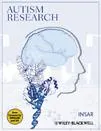[article]
| Titre : |
Object-Directed Imitation in Children With High-Functioning Autism: Testing the Social Motivation Hypothesis |
| Type de document : |
texte imprimÃĐ |
| Auteurs : |
Mark NIELSEN, Auteur ; Virginia P. SLAUGHTER, Auteur ; Cheryl DISSANAYAKE, Auteur |
| AnnÃĐe de publication : |
2013 |
| Article en page(s) : |
p.23-32 |
| Langues : |
Anglais (eng) |
| Mots-clÃĐs : |
social cognition overimitation synchronic imitation social learning autism |
| Index. dÃĐcimale : |
PER Périodiques |
| RÃĐsumÃĐ : |
Children with autism show clear deficits in copying others' bodily oriented actions whereas their capacity for replicating others' object-directed actions appears relatively spared. One explanation is that unlike bodily oriented actions, object-directed actions have tangible, functional outcomes and hence rely far less on social motivations for their production. To investigate this, we compared the performance of a group of children with high-functioning autism (HFA) and a group of typically developing (TD) children on two distinct object-directed tasks that are considered highly social: overimitation and synchronic imitation. Our findings were surprising. The HFA children copied all of a modeling adult's actions, including those that had no function or purpose (i.e. they overimitated), and they entered into extended bouts repeating an arbitrary action along with the adult who had a similar object to play with (i.e. they engaged in synchronic imitation). Moreover, they did so at rates indistinguishable from the TD children. This work demonstrates that the capacity and propensity for overimitation and synchronic imitation are intact in children with HFA, and questions whether socially based imitation should be considered an autism-specific deficit. |
| En ligne : |
http://dx.doi.org/10.1002/aur.1261 |
| Permalink : |
https://www.cra-rhone-alpes.org/cid/opac_css/index.php?lvl=notice_display&id=192 |
in Autism Research > 6-1 (February 2013) . - p.23-32
[article] Object-Directed Imitation in Children With High-Functioning Autism: Testing the Social Motivation Hypothesis [texte imprimÃĐ] / Mark NIELSEN, Auteur ; Virginia P. SLAUGHTER, Auteur ; Cheryl DISSANAYAKE, Auteur . - 2013 . - p.23-32. Langues : Anglais ( eng) in Autism Research > 6-1 (February 2013) . - p.23-32
| Mots-clÃĐs : |
social cognition overimitation synchronic imitation social learning autism |
| Index. dÃĐcimale : |
PER Périodiques |
| RÃĐsumÃĐ : |
Children with autism show clear deficits in copying others' bodily oriented actions whereas their capacity for replicating others' object-directed actions appears relatively spared. One explanation is that unlike bodily oriented actions, object-directed actions have tangible, functional outcomes and hence rely far less on social motivations for their production. To investigate this, we compared the performance of a group of children with high-functioning autism (HFA) and a group of typically developing (TD) children on two distinct object-directed tasks that are considered highly social: overimitation and synchronic imitation. Our findings were surprising. The HFA children copied all of a modeling adult's actions, including those that had no function or purpose (i.e. they overimitated), and they entered into extended bouts repeating an arbitrary action along with the adult who had a similar object to play with (i.e. they engaged in synchronic imitation). Moreover, they did so at rates indistinguishable from the TD children. This work demonstrates that the capacity and propensity for overimitation and synchronic imitation are intact in children with HFA, and questions whether socially based imitation should be considered an autism-specific deficit. |
| En ligne : |
http://dx.doi.org/10.1002/aur.1261 |
| Permalink : |
https://www.cra-rhone-alpes.org/cid/opac_css/index.php?lvl=notice_display&id=192 |
|  |


